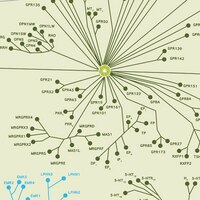HTS091M Sigma-AldrichChemiSCREEN™ Human DP Prostanoid Receptor Membrane Preparation
Human DP GPCR membrane preparation for Radioligand binding Assays & GTPgammaS binding.
More>> Human DP GPCR membrane preparation for Radioligand binding Assays & GTPgammaS binding. Less<<Produits recommandés
Aperçu
| Replacement Information |
|---|
Tableau de caractéristiques principal
| Species | Host Cells | Protein Target |
|---|---|---|
| Human | Chem-1 | DP |
| References |
|---|
| Product Information | |
|---|---|
| Format | Membranes |
| Presentation | Liquid in packaging buffer: 50 mM Tris pH 7.4, 10% glycerol and 1% BSA no preservatives. Packaging method: Membranes protein were adjusted to 0.5 mg/ml in 1 ml packaging buffer, rapidly frozen, and stored at -80°C. |
| Quality Level | MQ100 |
| Physicochemical Information |
|---|
| Dimensions |
|---|
| Materials Information |
|---|
| Toxicological Information |
|---|
| Safety Information according to GHS |
|---|
| Safety Information |
|---|
| Storage and Shipping Information | |
|---|---|
| Storage Conditions | Maintain frozen at -70°C for up to 2 years. Do not freeze and thaw. |
| Packaging Information | |
|---|---|
| Material Size | 200 units |
| Transport Information |
|---|
| Supplemental Information |
|---|
| Specifications |
|---|
| Global Trade Item Number | |
|---|---|
| Référence | GTIN |
| HTS091M | 04053252624117 |
Documentation
ChemiSCREEN™ Human DP Prostanoid Receptor Membrane Preparation FDS
| Titre |
|---|
ChemiSCREEN™ Human DP Prostanoid Receptor Membrane Preparation Certificats d'analyse
| Titre | Numéro de lot |
|---|---|
| CHEMISCREENTM MEMBRANE PREPARATION RECOMBINANT HUMAN DP PROSTANOID RECEPTOR - 2349734 | 2349734 |
Références bibliographiques
| Aperçu de la référence bibliographique | Nº PubMed |
|---|---|
| Genetic and pharmacological analysis of prostanoid receptor function Narumiya, S and FitzGerald, G A J Clin Invest, 108:25-30 (2001) 2001 | 11435452
 |
| Prostaglandin D2 as a mediator of allergic asthma Matsuoka, T, et al Science, 287:2013-7 (2000) 1999 | 10720327
 |
Fiche technique
| Titre |
|---|
| CHEMISCREEN MEMBRANE PREPARATION RECOMBINANT HUMAN DP PROSTANOID RECEPTOR |









